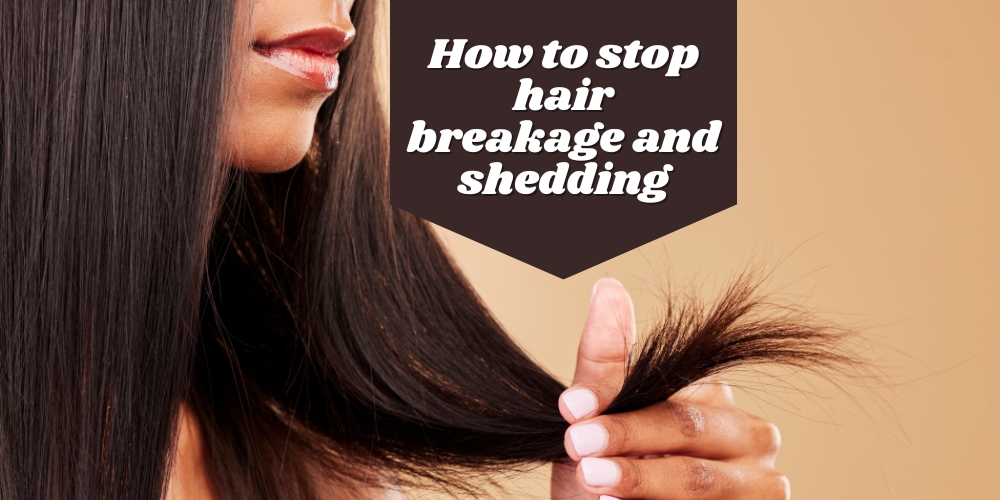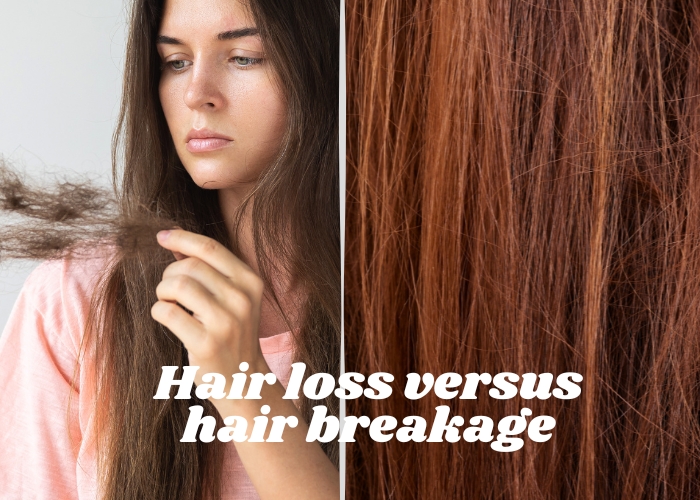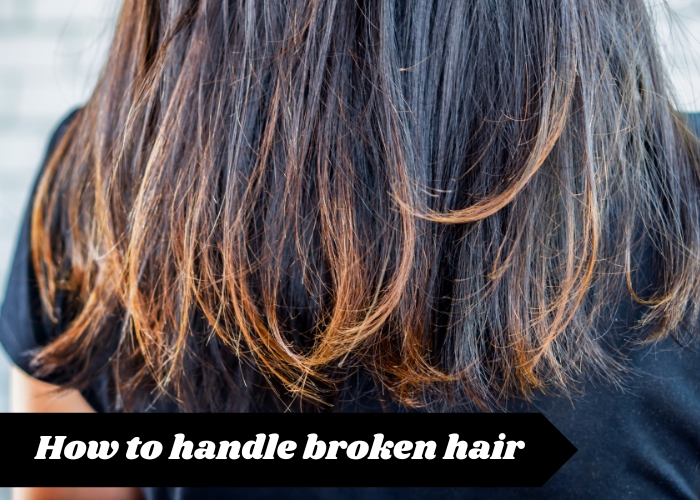In addition to other factors, stress and heat can also lead to hair breakage. Find out what might be causing and how to stop hair breakage.There are numerous reasons why hair breaks. An inner cuticle with overlapping scales that holds your hair strands together is essential for healthy hair. Your hair may get dry and eventually split as a result of these falling scales, causing damage. In addition to other symptoms like frizz and dryness, this results in breaking.Let’s talk about how to stop hair breakage and shedding.
What is hair breakage?
When the structure of hair strands is damaged, hair breaking happens. The cortex, the centre of each hair strand, is encased in the cuticle, which serves as a protective coat. Healthy hair has a flat, unbroken cuticle layer because the cuticle is made up of overlapping scale-like layers that keep the hair strong and smooth.The cuticle can be damaged by external causes like lifestyle decisions and environmental conditions. This damage has the potential to raise or even eliminate cuticle layers, weakening the protective covering of hair. This results in a loss of cuticle integrity and health, making hair more prone to breaking and frequently seeming dull and rough to the touch.
How does hair breakage appear?
Effectively managing hair breakage requires the ability to identify it. Split ends, which occur when a hair strand breaks into two or more pieces, usually at the tip, are a common indicator of hair breakage and are frequently the most obvious one. Furthermore, hair may seem shorter in specific places, which would suggest strand breaking.
Increased stray, short hairs that are not a part of your natural hairline or the typical shedding process are two other signs. These shorter hairs frequently protrude from your hair’s main length or the scalp. Breakage can cause hair to appear frizzy or dull, devoid of its smooth structure and natural shine.
Hair loss versus hair breakage
It’s critical to recognise the differences between hair loss and breakage because they are two distinct disorders with different causes. Split ends and decreased hair lengths are the results of the weakening and eventual snapping of the hair shaft, which is known as hair breakage. Usually, this kind of hair damage happens all the way along the hair strand.
On the other hand, hair loss is the term for hair falling out of the scalp, frequently from the roots. Numerous things, such as dietary modifications, hormone imbalances, physical or mental trauma, medical treatments, and ageing-related issues, might contribute to it. Hair loss can also result from some medical diseases, such as the autoimmune ailment alopecia areata. Hair loss is the diminution of hairs on the scalp, as opposed to breakage, which affects the hair shaft.To find the underlying cause and the best course of action for treating hair loss, speak with a medical practitioner, such as a dermatologist or doctor.
Why do hair strands break?
Have you ever wondered why your hair keeps breaking? The following are the main reasons why hair breaks:
- Dehydration: Hair that is too dry is more likely to break. Hair can become more dry when natural oils are removed by excessive washing. Reducing how often you wash your hair and using moisturising products will assist if it’s frizzy or brittle.
- Heat styling: Using heat styling equipment excessively and without protection can cause damage to hair and dryness. Frequent use and high temperatures raise the possibility of breaking. This risk can be reduced by using a heat protectant, such our Restore Perfecting Spray.
- harsh treatments: By dismantling the structure of hair, treatments like chemical straightening, relaxers, and perms can weaken it. Reduce damage by staying away from strong chemicals and thinking about hair treatments that coat the hair without going to the root.
- Hard water: The minerals in hard water can accumulate on hair, obstructing the hydration-absorbing process and causing breaking. A clarifying shampoo can assist in reversing this impact.
- Hair ties: Rough hair ties and tight hairstyles can break hair. This risk can be decreased by choosing looser designs and softer scrunchies.
- Friction: Using towels, brushes, and pillowcases roughly can lead to damage. Friction can be decreased with the use of silk pillows, wide-tooth combs, and microfiber towels.
- Having curly hair: Hair that is curly tends to be dryer and more brittle. Its health can be preserved by regular moisturising, applying hair masks, and utilising products designed specifically for curly hair.
How to handle broken hair
In order to treat hair breakage, damage must be repaired as well as future breakage must be avoided. To help you attain healthier, stronger hair, consider the following four hair breakage treatment suggestions:
Nutrition
The adage “you are what you eat” is true in many ways, particularly in regards to the condition of your skin and hair. Certain nutrients prevent breakage from injury and aid in hair growth Source. Verify that your regular diet has adequate amounts of folic acid, iron, and zinc.
Tension
Numerous studies have linked stress to hair loss, and stress itself has been linked to hair breaking in the past.One prevalent form of alopecia connected to hair destruction and most likely brought on by stress is telogen effluvium.
Lack of moisture
One sign of damage and breakage of hair could be abnormally dry hair.Numerous other conditions, such as dry weather, low humidity, and excessive heat, could also be the reason. When washing your hair, make sure to use warm water instead than hot, as the latter may cause more dryness.Think about using shampoo exclusively on your scalp if your ends are dry. Conditioner should also not be skipped. On the middle and ends of your hair, think about attempting a hair mask.
Damage from heat
You need high heat if you want the greatest results from your curling iron, flat iron, or hair dryer. But, excessive or improper use of these instruments puts the cuticle at danger of being harmed by high heat. Taking a weekly break from all styling equipment for your hair is one approach to avoid overall heat damage. Choose ceramic styling tools to lessen the actual heat damage they do. They heat up more evenly, allowing you to stop using them on the same hair areas repeatedly.
Excessive processing
After the first or second session, professional straightening, colouring, relaxers, and perms can all give the impression that your hair is healthier. However, overusing these services might harm your hair by causing the cuticle to deteriorate. Additionally, permanent hair dye may interact with your scalp and result in contact dermatitis.
Excessive washing
You’re also more prone to produce too much sebum, or natural oil, on your scalp if you have oily skin. This may make you feel tempted to wash your hair more frequently than is necessary. If you have oily hair, washing your hair once a day is okay, but washing it more than once a day is not recommended. Conversely, really dry hair might just require a weekly shampooing from Trusted Source. Additionally, be sure to apply conditioner smoothly from your ends to your roots and shampoo your hair gently.
Inadequate towel drying
It’s normal to massage a towel over your skin and hair as soon as you step out of the shower. But in reality, this rubbing motion weakens your hair right after it becomes wet, when it is most susceptible.Blot an absorbent towel around your hair to remove any remaining water rather than wiping it out. As a temporary solution, you can also place a towel in your hair to absorb extra water.
The lesson learnt
Breaking hair can be annoying. The majority of underlying issues may be fixed, which is good news.After making adjustments to your food and hair regimen, if your hair breakage persists, it could be necessary to visit a doctor to rule out any underlying medical conditions.



